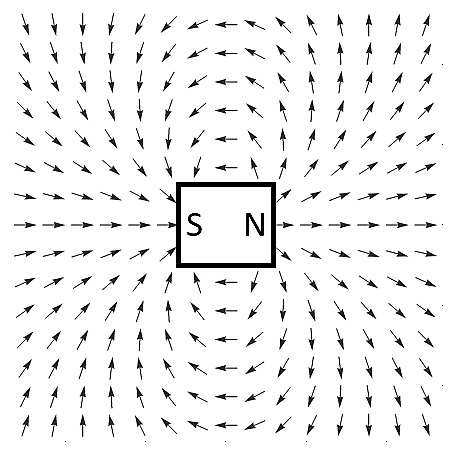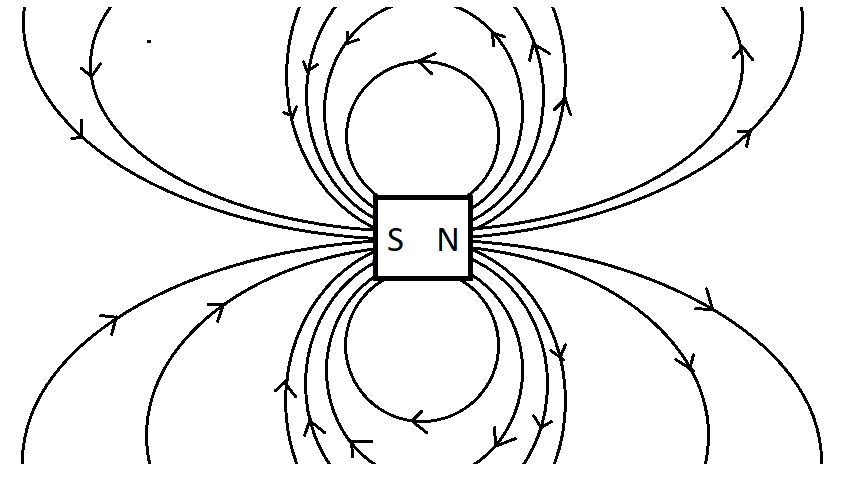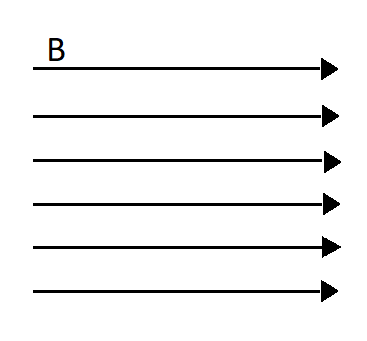
In a uniform magnetic field, the field lines are
Answer
508.2k+ views
Hint: In order to answer the question, we will study the magnetic field. We will discuss magnetic field lines. We will look upon uniform and non-uniform magnetic fields and its corresponding magnetic field lines.
Complete answer:
First of all, we will shine some light onto some of the basic things such as what is a magnetic field as well as what do we mean by magnetic field lines.
A magnetic field is a visual representation of how magnetic force is distributed in the space around and inside a magnetic object. Most of us are familiar with common magnetic objects and are aware that forces can exist between them. We know that magnets have two poles and that the orientation of two magnets can cause attraction (opposite poles) or repulsion (opposite poles) (similar poles). We understand that this occurs in an area stretching around a magnet.
The magnetic field is mathematically defined as a vector field. This vector field can be plotted directly on a grid as a set of several vectors. Each vector has a length that is proportional to the intensity of the magnetic force and points in the same direction as a compass.

Field lines are another way to describe the information found within a vector field. We don't use the grid pattern here, instead connecting the vectors with smooth lines. We are free to draw as many lines as we want.

Now, we will be discussing about uniform and non-uniform magnetic fields as well as magnetic field lines respectively:
If the magnetic induction has the same magnitude and direction at all points in the vicinity, the magnetic field is said to be uniform. A uniform magnetic field is one in which the magnetic field lines move in a straight line from the North to the South Pole of a magnet with a uniform severance; this is impossible to do with a single stable magnet.

The magnetic field is said to be non-uniform if the magnetic induction varies in magnitude and direction across an area. A bar magnet generates a non-uniform magnetic field. If the magnetic field in a given area has different magnetic intensities at different locations, the magnetic field is said to be non-uniform. Non-uniform magnetic fields include convergent, divergent, majority of magnets, magnetic fields, and so on.

Non-uniform magnetic field lines are curved, while uniform magnetic field lines are starlight lines. Non-uniform magnetic field lines are not parallel to each other; uniform magnetic field lines are.
Finally, after all the discussion we did, we can conclude that the magnetic field lines of a uniform magnetic field move in a straight line with equal magnitude and are parallel to each other.
Note:
It is very important to note that the magnetic field lines travel from the North pole to the South pole. If the magnetic field is due to some sort of a bar magnet, then the magnetic field lines will travel from its North pole to the South pole outside the magnet. Whereas, it will travel from the South pole to the North inside of a bar magnet.
Complete answer:
First of all, we will shine some light onto some of the basic things such as what is a magnetic field as well as what do we mean by magnetic field lines.
A magnetic field is a visual representation of how magnetic force is distributed in the space around and inside a magnetic object. Most of us are familiar with common magnetic objects and are aware that forces can exist between them. We know that magnets have two poles and that the orientation of two magnets can cause attraction (opposite poles) or repulsion (opposite poles) (similar poles). We understand that this occurs in an area stretching around a magnet.
The magnetic field is mathematically defined as a vector field. This vector field can be plotted directly on a grid as a set of several vectors. Each vector has a length that is proportional to the intensity of the magnetic force and points in the same direction as a compass.

Field lines are another way to describe the information found within a vector field. We don't use the grid pattern here, instead connecting the vectors with smooth lines. We are free to draw as many lines as we want.

Now, we will be discussing about uniform and non-uniform magnetic fields as well as magnetic field lines respectively:
If the magnetic induction has the same magnitude and direction at all points in the vicinity, the magnetic field is said to be uniform. A uniform magnetic field is one in which the magnetic field lines move in a straight line from the North to the South Pole of a magnet with a uniform severance; this is impossible to do with a single stable magnet.

The magnetic field is said to be non-uniform if the magnetic induction varies in magnitude and direction across an area. A bar magnet generates a non-uniform magnetic field. If the magnetic field in a given area has different magnetic intensities at different locations, the magnetic field is said to be non-uniform. Non-uniform magnetic fields include convergent, divergent, majority of magnets, magnetic fields, and so on.

Non-uniform magnetic field lines are curved, while uniform magnetic field lines are starlight lines. Non-uniform magnetic field lines are not parallel to each other; uniform magnetic field lines are.
Finally, after all the discussion we did, we can conclude that the magnetic field lines of a uniform magnetic field move in a straight line with equal magnitude and are parallel to each other.
Note:
It is very important to note that the magnetic field lines travel from the North pole to the South pole. If the magnetic field is due to some sort of a bar magnet, then the magnetic field lines will travel from its North pole to the South pole outside the magnet. Whereas, it will travel from the South pole to the North inside of a bar magnet.
Recently Updated Pages
Master Class 12 Business Studies: Engaging Questions & Answers for Success

Master Class 12 Economics: Engaging Questions & Answers for Success

Master Class 12 English: Engaging Questions & Answers for Success

Master Class 12 Maths: Engaging Questions & Answers for Success

Master Class 12 Social Science: Engaging Questions & Answers for Success

Master Class 12 Chemistry: Engaging Questions & Answers for Success

Trending doubts
Who was the first woman to receive Bharat Ratna?

Write a letter to the principal requesting him to grant class 10 english CBSE

Why is there a time difference of about 5 hours between class 10 social science CBSE

What is the median of the first 10 natural numbers class 10 maths CBSE

The Equation xxx + 2 is Satisfied when x is Equal to Class 10 Maths

Discuss the main reasons for poverty in India




